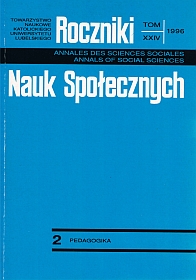The Religious Life of the Charges of the Holy Spirit Hospital in Rome in the 17th and 18th Centuries
Abstract
The Holy Spirit hospital was founded by Innocent III in Rome in 1198. It was administered and run by the order of Holy Ghost Fathers. For many ages it was the greatest hospital in the Christian world and it specialized mainly in the care about abandoned children. The majority of those children, after an approximately ten year-period stay in the homes of non-hospital wet nurses, were given to service, to learn craft or marry. Some part of them, however, remained in the hospital. The girls were located in the so-called Conservatorio, whereas the boys in the so-called Scuola dei Putti.
The charges of the Holy Spirit hospital in Rome, similarly as in other charitable institutions of this type, received religious education and religious practices. The religious life in the hospital under discussion was formed by the religious who permanently stayed there (Holy Ghost Fathers and Mothers). The hospital had direct links with the Vatican, and this obliged it to develop particular religious zeal among its charges. Being a papal hospital („Archiospedale Apostolico”) it constituted a pattern and model for other hospital institutions, also in the sphere of the formation and organization of a religious life.
Baptism was deemed a very important fact in the process of the formation of religious attitudes in foundlings. They were baptized immediately after being admitted to the hospital, and then they received the Holy Communion at the age of 12. The children who stayed longer in the poor-house. There they received the sacrament of confirmation.
The hospital charges often had to go to confession and receive the holy communion. The record of religious practices developed and binding in the hospital was extremely rich. The type and intensity of religious practices depended on the age of the inmates. Each day began with morning services, prayers and the holy mass. Having fulfilled the spiritual duties, all the inhabitants of „Conservatorio” went to breakfast, and then they started their daily physical works. They also had to listen to and recite the Catholic doctrine and sing spiritual songs. After the morning works there was lunch, during which religious texts were being read, they prayed for the deceased inhabitants and benefactors of the hospital. After lunch all the charges of the poor-house went back to their work. Their day closed with supper and common evening prayers.
Copyright (c) 1996 Roczniki Nauk Społecznych

This work is licensed under a Creative Commons Attribution-NonCommercial-NoDerivatives 4.0 International License.


